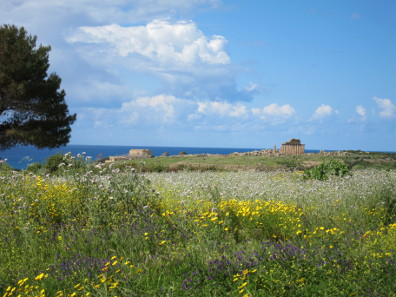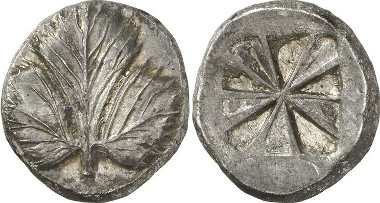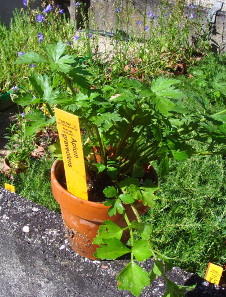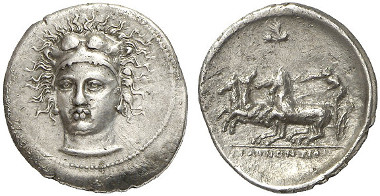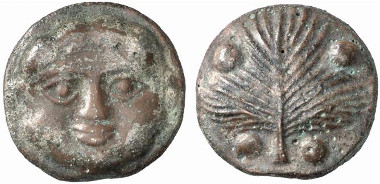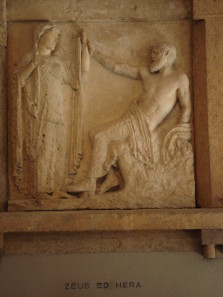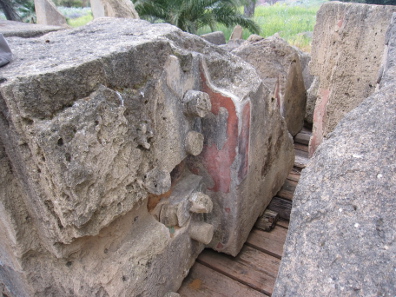by Ursula Kampmann
translated by Teresa Teklic
June 19, 2014 – You only realise just how diverse Sicily is once you take a look at the many different microclimates. During the summer that is impossible. Then, it is simply blazing hot everywhere. But not in springtime. The most dazzling sunshine in one valley swiftly changes into the most horrendous combination of incessant, pouring rain and fierce winds. At least it usually doesn’t take long until the weather changes again.
Saturday, April 19, 2014
On our agenda for Saturday was Selinus (now Selinunte). Selinus, the city that became Segesta’s chief antagonist. We expected the day to be long and exhausting, as the excavation of Selinus covers a vast area of 40 hectares.
The excavation area is too large to capture in a single shot. Photo: KW.
30,000 people – and a host of slaves – presumably populated Selinus in the 5th century BC, the city’s heyday. The settlement had been established by people who knew the area well. The Greek colony Megara Hyblaea, some 20 km northwest of Syracuse, needed to find a suitable location to settle more incoming emigrants from their hometown Megara. And an eminently suitable location was found, right by the sea, between the mouths of the rivers Selinus and Hypsas.
Selinus. Didrachm, 480-466. From Gorny & Mosch auction sale 195 (2011), 55.
When exactly Selinus was founded is not recorded, but it must have been some time during the second half of the 7th century.
Apium graveolens, from: O. W. Thomé, Flora von Deutschland, Österreich und der Schweiz. Gera (1885). Source: Wikipedia.
Selinus derives its name from the Greek word “selinon” …
A wild form of Apium graveolens, Botanischer Garten in Frankfurt. Photo: Karl-Heinz Wellmann, CC-BY-SA-3.0.
…which refers to a plant named Apium graveolens, also known as celery. The vegetable grows especially well on wet and marshy ground, which already tells us something about the problems the first settlers had to face. The plant further requires the ground to be salt-containing, which was given in Selinus due to its proximity to the sea.
Selinus. Tetradrachm, 466-450. Artemis and Apollon on Biga. Rv. River god making an offering at the altar. From Gorny & Mosch auction sale 219 (2014), 53.
Of course Selinus was not founded in a geopolitical vacuum. There were neighbours. Not all of whom were too happy about this development. Selinus was the most western outpost of Greek culture in Sicily. It was in close proximity to the Carthaginian trading bases. But the Carthaginians weren’t the problem, the Elymi in Segesta were. They did not watch the rapidly expanding Selinus grow closer to their territory with joy.
Selinus. Stater, around 450. Young Heracles taming the Cretan Bull. Rv. River god Hypsas making an offering. From Gorny & Mosch auction sale 125 (2003), 53.
And moderation did not seem to be among the virtues of the settlers in Selinus. They wanted their city to grow and that required additional fields in order to produce the necessary corn. More than one war with the former owners, the Elymi, was the result. The new arrivals had the upper hand in the competition with the long-time residents. And so the new seaport grew. Its geographical location was ideal for trading. And thus Selinus had its heyday in the 5th century.
City map of Selinus (1910). Source: University of Heidelberg / Wikipedia.
The end of the 5th century – once again – saw a conflict with Segesta. Selinus blocked the Segestans’ access to the sea. Selinus was self-confident, support from the Greeks was counted on. Syracuse supported Selinus. Segesta, on the other hand, was on the verge of bankruptcy and in dire need to find an ally. No party on Sicily seemed strong enough to compete with the Siracusani. So it came to an alliance between Segesta and Athens.
Selinus. Hemidrachm, 415-409. From Gorny & Mosch auction sale 211 (2013), 75.
The Athenian military leader Nikias suggested launching a direct strike against Selinus. But that plan could not be reconciled with Athenian pride. If they were going to strike, then it had to be Syracuse, nothing less. And it was precisely this arrogance that led to one of the biggest disasters in Athenian history. Selinus was victorious. Segesta lost. Every concession agreed to by the Segestans was followed by more demands on the part of Selinus. Until the Segestans were desperate enough to turn to Carthage for help.
Selinus. Bronze Trias, 435-415. From Künker auction sale 133 (2007), 7236.
Carthage, after a brief moment of hesitation, sent a small army and, with united forces, Segesta defeated Selinus in battle. And at this occasion, the Carthaginians witnessed themselves that the Greeks on Sicily were not as powerful anymore as they had been in 480 BC.
Selinus. Bronze-Hemilitra, 415-409. From Künker auction sale 133 (2007), 7237.
Which is why, in the following spring, a large army, led by the grandson of the general who had died in the Battle of Himera, set sail. It landed in Lilybaion and marched straight on Selinus, taken completely by surprise and accordingly unprepared. The support promised from Syracuse, Gela and Akragas was long in coming, and so the city was seized. Sources speak of 16,000 dead, 5,000 prisoners and 2,600 soldiers fled to Akragas.
Karl Briullov. Tourists of the 19th century in Selinus. Source: Wikipedia.
Although the city walls were destroyed, survivors were allowed to return. Survivors there were, but the city’s time was over, at the latest when the Carthaginians resettled everyone from Selinus to Lilybaion at the end of the First Punic War. The geographer Strabo (64/3 BC – AD 24) only knew it as a dead city.
Site plan including tracks of the electric tram. Photo: KW.
You can’t say that Selinus is dead today. On the contrary. There is a huge parking lot with enough room for innumerable busses, a number of souvenir shops and a large bar. Most tourists confine their visit to the temple. Only very few spend money on a ticket for the electric tram which on its tour covers the East Hill, the Acropolis and the northern area of the site.
Temple E. Photo: KW.
Temple E, which is believed to have been dedicated to Hera due to the inscription on the votive stela, receives most of the attention.
Metope of Temple E depicting Zeus and Hera. Photo: G. Dall’Orto / Wikipedia. CC BY-SA 2.5.
The metopes of this and all other temples are kept at the distinguished archaeological museum in Palermo that has unfortunately been closed for several years now, due to constant renovation works. I wonder how long this is going to take. But who knows … The museum’s homepage doesn’t say. Instead, it informs visitors that there is a team of 31 people behind the institution, including curators, scholars and administrative staff. Quite impressive!
A look inside Temple E. Photo: KW.
Almost as impressive as taking a look inside Temple E, which, excellently reconstructed, reveals the structures of the adyton. The adyton was an area separated from the rest of the temple where cult image, votive offerings and ritual instruments were kept until needed for the rituals at the temple altar.
Temple F. Photo: KW.
Temple F receives considerably less attention. It is, as the guide book informs us, the oldest and smallest in the cluster of temples, possibly dedicated to Athena or Dionysus. Be that as it may, the huge dark cloud approaching from this direction eventually began to capture our attention more than the temple did.
Temple G. Photo: KW.
Temple G used to be counted among the biggest temples in the whole of the ancient Greek world. Today all that is left is a heap of ruins that invites many tourists to climb it. It may have been dedicated to Apollo, or perhaps Zeus.
Chunk of architectural structure with original ornamental painting. Photo: KW.
Heroically we tried to ignore the pouring rain, which by now had formed an unpleasant alliance with gusts of chilly winds. As we made our way around the area, we could see it gradually emptying out. Understandably enough. Not even we could muster genuine enthusiasm at the sight of the colourful chunks of old architecture piled up. We decided to take a break and wait out the rain in the bar just outside the excavation area. Which, of course, was exactly what everybody else did. At least the owner of the café was happy and sold us hot chocolate, espresso and tea. We waited half an hour, an hour, the rain didn’t let up. The first people surrendered, the parking lot began to empty.
We hung on a little longer than the rest, but when the rain went from pouring to torrential, we too gave up. Got in our car, pretended to have another look at the excavation sites by driving around it and headed homewards. A few kilometres down the road the whole spectacle dissolved in thin air. The sun was shining again, but you could still see the dark cloud hovering over Selinus.
We used the opportunity to go shopping in Castelvetrano. Which wasn’t as easy as you should think. It took us a tour around the entire city until we finally discovered an open supermarket. However, we were rewarded for our efforts with a friendly reception in fluent Bavarian at the meat counter. The butcher had worked in Bavaria for several years in his youth. He was very excited to get a chance to practise his German once more. And a little wistful when he remarked that there had been more to do in Munich than there was in Castelvetrano.
We bought our lunch from him and had it in the most glorious sunshine back in Balata di Baida. And this brings us back to the issue of microclimates. Reliable weather forecasts for the whole of the island seem to be a thing of impossibility in spring and autumn. Each valley produces a distinct weather. And sometimes the rain just happens to be where you want to go next.
In the next episode of “Sicily in full bloom” we will take a trip to the island of Motya to inspect the remnants of a Carthaginian settlement. Including a tophet where the Carthaginians sacrificed children!
And here you can find all episodes of “Sicily in full bloom”.




